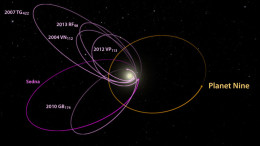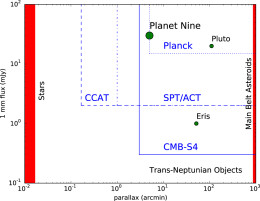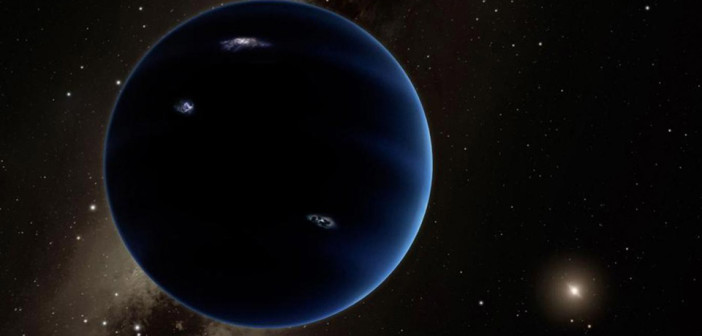Recent studies have identified signs of an unseen, distant ninth planet in our solar system. How might we find the elusive Planet Nine? A team of scientists suggests the key might be cosmology experiments.
A Hypothetical Planet

Orbits of six distant Kuiper-belt objects. Their clustered perihelia and orbital orientations suggest they may have been shepherded by a massive object, hypothesized to be Planet Nine. [Caltech/Robert Hurt]
In a recent study, a team of scientists led by Nicolas Cowan (McGill University in Canada) has estimated the blackbody emission expected from Planet Nine. The team proposes how we might be able to search for this distant body using its heat signature.
Heat from an Icy World
Cowan and collaborators first estimate Planet Nine’s effective temperature, based on the solar flux received at ~700 AU and assuming its internal heating is similar to Uranus or Neptune. They find that Planet Nine’s effective temperature would likely be an icy ~30–50 K, corresponding to a blackbody peak at 50–100 micrometers.

Search space for Planet Nine. Based on its millimeter flux and annual parallax motion, several current and future cosmology experiments may be able to detect it. Experiments’ resolution ranges are shown with blue boxes. [Cowan et al. 2016]
There’s one major catch: how can we differentiate between Planet Nine and the ~4000 foreground asteroids that are brighter than 30 mJy at millimeter wavelengths?
Cowan and collaborators argue that this can be done using a combination of asteroid databases and parallax measurements. The authors calculate that Planet Nine should move roughly a few arcseconds per day, mostly due to parallax. In comparison, asteroids will move ~10 arcminutes per day in a combination of proper motion and parallax — an order of magnitude faster than Planet Nine.
Resolution Constraints
To hunt down Planet Nine, we therefore need telescopes that can not only resolve a 30 mJy point source, but can also resolve an annual parallax motion of ~5 arcminutes per year.
The authors demonstrate that several current and planned CMB experiments have the resolution and ability to detect Planet Nine, provided that they map large swatches of the sky and return to the same regions every few months. These experiments include CCAT, the South Pole Telescope, the Atacama Cosmology Telescope, CMB-S4, and even possibly Planck.
With the astronomical community coming together to brainstorm ways to track down this elusive possible planet, the use of CMB experiments is an intriguing option. And even if Planet Nine is discovered by other means, measuring its heat signature will teach us more about the internal workings of giant planets.
Citation
Nicolas B. Cowan et al 2016 ApJ 822 L2. doi:10.3847/2041-8205/822/1/L2


3 Comments
Pingback: new method for finding another planet?
Pingback: An Update on Planet Nine
Pingback: Kan Planet IX gevonden worden door ‘oerknaltelescopen’?